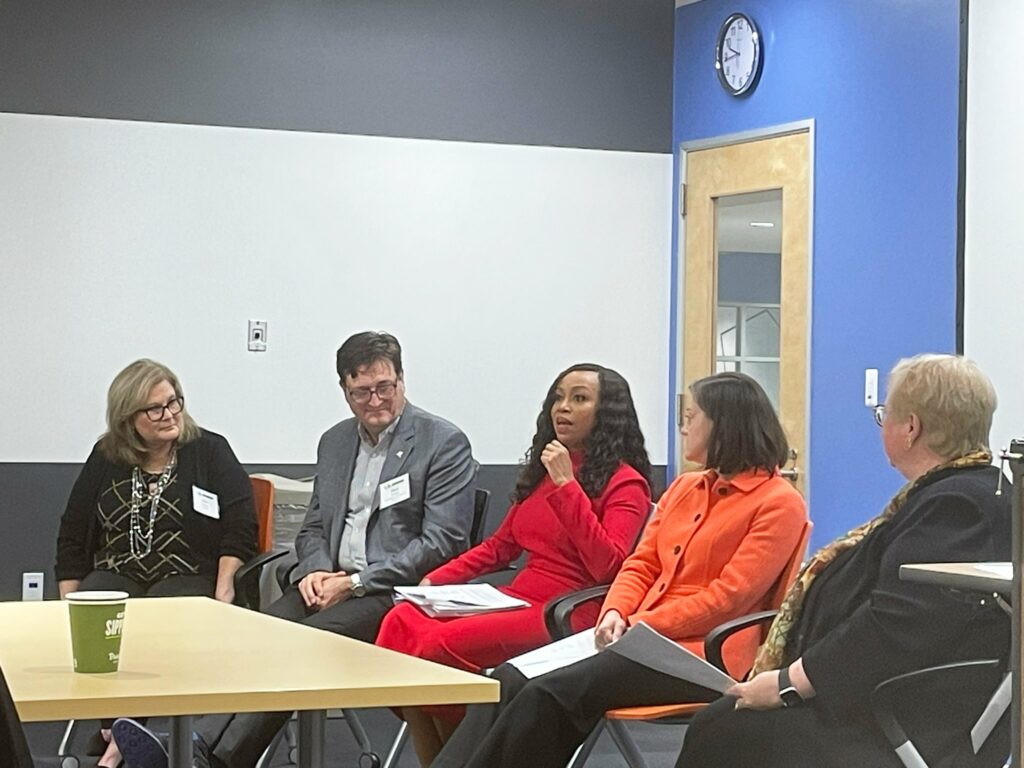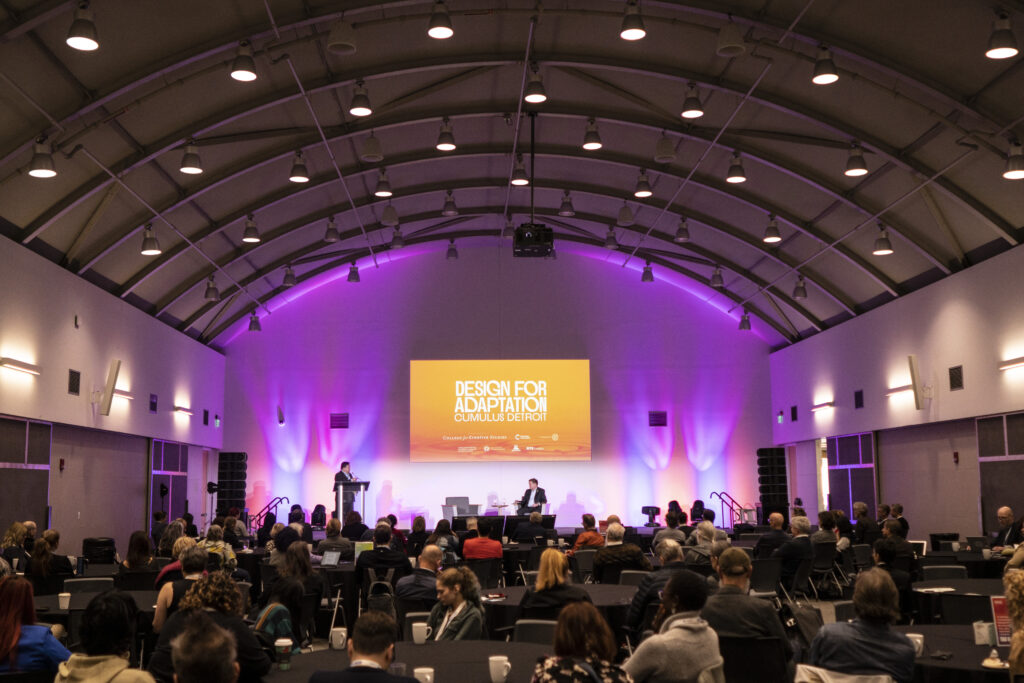This Month’s Message from Terry Barclay, SBN Detroit chair and CEO of Inforum

On Oct. 31, SBND hosted a panel focusing on business and sustainability in the Great Lakes region. The event was a collaboration with the Council of the Great Lakes Region and featured Shanelle Jackson, senior manager, LyondellBasell; Edna Lorenz, energy director, Corewell Health; Mark Schrupp, executive director, Detroit/Wayne County Port Authority; and Lillian Woolley, senior chemical engineer, Fishbeck. It was a fascinating discussion, and I encourage you to read the story here. Before the panel discussion, Colin Bird, counsel general of Canada in Detroit, spoke about how Canada and the U.S. work together on issues that include the environment, maritime trade, and stewardship of the Great Lakes. In Michigan, we are more aware of this than most in the U.S., but some of the specifics were new to me. Some examples: In 2022, Canada was the U.S.’s largest trading partner in goods and services. About 80% of Canadian goods exports to the U.S. ‘feed’ American supply chains for final goods. According to U.S. trade data, in 2022, bilateral trade in goods and services was US$914.3 billion, representing over US$2.5 billion worth of goods and services crossing the border every day. The joint stewardship of the environment is a cornerstone of Canada-U.S. relations, from air and water quality to wildlife management. This includes at least 50 federal bilateral arrangements, more than 100 arrangements at the state and provincial level, and the Boundary Waters Treaty of 1909. The Canada-U.S. Joint Action Plan on Critical Minerals Collaboration and the Memorandum of Understanding (MOU) expand energy cooperation between the two countries are some examples of collaborative initiatives. Canada’s 2023 federal budget allocates $650 million over ten years to support monitoring, assessment, and restoration work in key freshwater ecosystems, many of which are shared by Canada and the US. Of this total, $420 million will go towards restoring and protecting the Great Lakes, complementing significant U.S. efforts in this regard. On September 18, the University of Michigan announced an award of $5 million from the National Science Foundation to establish the Global Center for Understanding Climate Change Impacts on Transboundary Waters, comprised of U.S. and Canadian universities and Indigenous representatives. McMaster University will lead the Canadian side, with $3.75 million in funding provided by the National Science Foundation. More trade statistics specific to Michigan can be found here. Be sure to subscribe to our newsletter for regular updates on sustainable business practices in and around Detroit.
Cumulus Holds Global Design for Adaptation Conference in Detroit

Cumulus, a global association of art and design education and research, held its annual conference, Design for Adaptation in Detroit Nov. 1-4 at the College for Creative Studies. This marks only the second time in its 30-year history that the conference was in North America. Cumulus connects 350 member institutions across 63 countries to exchange knowledge and best practices to elevate the positive role of designers and artists in creating sustainable and humane futures for all. “If there is one thing we know, we are stronger together,” said Terry Barclay, SBN Detroit Chair and CEO of Inforum, in a Thursday afternoon welcome address. “I think we have a common sense of urgency to break down silos that slow collaboration and this conference is certainly about that.” SBN Detroit was a conference sponsor. “This international conference has such diverse participation,” said Neil Hawkins, president of the Fred A. and Barbara M. Erb Family Foundation, who moderated a keynote address. We have creative designers hoping to change the trajectory of climate disasters. We have local Detroit leaders demanding justice for people already suffering impacts. We have great minds from all corners of the earth here in Detroit, which in many ways can be called ground zero for the climate crisis.” To that end, he noted that metro Detroit has endured serious local flooding from three 500-year rainfalls in the last ten years, holds 25% of the world’s surface freshwater in the great lakes, and the state is fittingly named after a natural resource – Michigan meaning “big lake.” Ian Lambert, co-chair and submissions chair for Cumulus 2022 and also dean of graduate studies at the College for Creative Studies, said, “As the only UNESCO-designated city of design in the U.S., Detroit has an incredible history of makers and manufacturing and design, so it’s fitting that Cumulus was held here. And it’s huge for Detroit.” The conference – focusing largely on the issue of climate change, automation, and income inequality – explored the role designers play in fostering adaptation through a wide range of approaches, methods, visions, and experiments. In that vein, the mission is to think ahead to catalyze ideas to reduce vulnerabilities and foster resilience for communities. Noting that the world is 1.2 degrees Celsius warmer than at any point in human civilization and that 300 billion tons of carbon have been added to the atmosphere by humans, keynote speaker Mikko Ollikainen, head of the Adaptation Fund, said to the audience of designers, “You are the minds to shape the future and you have your work cut out for you. … “We are facing an increasing arrival of uncertainty and must be prepared for things we do not expect and prepared to withstand shocks.” Land use and its relationship to climate change and inequity were the focus of several panels. Anika Goss, CEO of Detroit Future City, said in her keynote, “When we look at the cities in Detroit and around the world that are hit hardest by climate change, it’s always the poorest and the brownest neighborhoods.” She pointed to a community on the lower east side that suffered stormwater flooding as an example, saying, “From an economic standpoint these families continue to lose value in their homes and property simply because they live in a neighborhood with poor infrastructure.” The Eastside Community Network is working to put residents in charge of enhancing their neighborhoods toward resiliency. President Donna Given referenced its LEAP Sustainability Fellowship saying, “When you give someone a small amount of money and the responsibility to build a better space it’s amazing what that can do to a neighborhood.” The fellowship is a training and development program where fellows develop community projects, apply for grant funds to support them, and then implement them with the help of the community. To that end, Jerry Hebron, executive director of Oakland Avenue Urban Farm, shared her story of growing up near Motown in its heyday, leaving the city, and then returning in 2005 to find it riddled by crime and decayed. She became an activist and was charged to find out what needs the community had. “I knocked on doors to collect information and found that housing and food were the residents’ most important needs.” The high vacancy rate and open land equaled opportunity. The community wanted a garden and they built one – 20×20 feet. Today, 14 years later, they are farming 3.5 acres, a farmers market, youth programming, and more. “The community reclaimed that land and worked together to change their neighborhood.” Linking this back to design, Lambert and Leslie Tom, chief sustainability officer at the Charles H. Wright Museum of African American History, presented a collaboration involving the repurposing of three dying trees on the museum’s property. Instead of letting the trees end up in a landfill, The Wright and the Center for Creative Studies repurposed the trees and created a curriculum around co-design for sustainability, climate justice, and African American material culture, out of which came a narrative around how two neighbors – a museum and an art school – set a precedent for climate justice art. “One of the pieces a student created spoke to land use in Detroit by combining window panels from an abandoned home and the repurposed timber to tell the story of decay and rebuild,” Lambert said. There is no doubt that the complex consequences of climate change have pushed the need for community resilient strategies to emerge and thrive in the face of change. About the role designers play in this, Ollikainen said, “How designers see the world and work has a profound impact on building sustainable solutions. You have the vision, and you have the skills to turn that vision into reality.” Be sure to subscribe to our newsletter for regular updates on sustainable business practices in and around Detroit.


